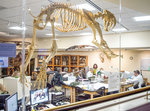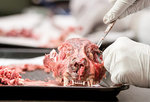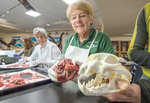, 61° F
Just a few feet from Corey Anco’s desk at the Draper Natural History Museum, employees and volunteers were busy removing the flesh from a mountain lion. They worked the paws, tail and skull …
This item is available in full to subscribers.
The Powell Tribune has expanded its online content. To continue reading, you will need to either log in to your subscriber account, or purchase a subscription.
If you are a current print subscriber, you can set up a free web account by clicking here.
If you already have a web account, but need to reset it, you can do so by clicking here.
If you would like to purchase a subscription click here.
Please log in to continue |
|





Just a few feet from Corey Anco’s desk at the Draper Natural History Museum, employees and volunteers were busy removing the flesh from a mountain lion. They worked the paws, tail and skull prior to the skeletal remains going into a colony of beetles that will strip every nook and cranny clean.
Some folks might be offended by the smell, but to the team it simply smells like science. The museum is a salvage-based institution, meaning with rare exception, they don’t collect any animals from the wild.
The lion was lethally removed from the wild by the Wyoming Game and Fish Department for livestock depredation. A year earlier the young lion’s mother was also removed. Unfortunately, her targeting of domestic sheep was passed down to her cub, putting it in jeopardy at a young age. They will be reunited in the museum’s educational archive after the long process of stripping their flesh is finished.
It’s not exactly a pleasant ending for the majestic creatures, but the museum aims to make the best of the situation.
Predators in this predicament have two destinations; they either end up in the landfill or they can go to a repository to be used for educational research.
The department has donated specimens to several entities, including Powell High School’s taxidermy class, but the museum often receives the donations for their studies and displays. The museum recently completed articulations (a mount of only the skeleton) of a grizzly bear scratching its back on a tree and the lion reaching for prey, extending its paw to show its impressive lethal weapon.
Anco, who started his career as assistant curator at the museum in 2017, forged a relationship with Game and Fish soon after arriving and was able to successfully apply for the carcasses of the two carnivores, as well as several more over the years.
The museum’s work for each carcass can take weeks or months. The process of creating a display can take years and not all specimens will be on display. Much of what happens in the lab is destined for the museum’s research catalog.
Anco was named curator of the museum last week. He had been the interim curator since 2022 after the former curator Nathan Doerr left to pursue another opportunity.
“Corey Anco rose above many other highly qualified applicants when I hired him as the Draper Museum’s Assistant Curator after a lengthy national search in 2017,” Preston said.
“He has continued to learn and grow significantly as assistant and interim curator, and I’m very excited for the future of Draper Natural History Museum with Corey at the helm. He brings a wealth of experience, knowledge, and passion to this challenging position.”
Executive Director and CEO of the Buffalo Bill Center of the West Rebecca West said Anco “demonstrated professional growth and a true dedication to the Draper, the Center, the Cody community, and the Greater Yellowstone Ecosystem” prior to his promotion to Willis McDonald IV Curator of Natural Science for the Draper Natural History Museum.
Anco, who is originally from Lemont, Illinois (a suburb of Chicago), didn’t initially begin his career in science with a goal of entering museum curation, he said. But once he experienced all that the industry offered, he was hooked.
He started his education near home, receiving his bachelor’s of science and environmental science from Lewis University in Romeoville, Illinois. While at Lewis, Anco worked for the Forest Preserve District of Kane County, as well as Midewin National Tallgrass Prairie, in Wilmington, Illinois, with the U.S. Forest Service.
He then received the first of his two master’s degrees from Duke University in environmental management. While at Duke he was with the National Geographic big cats initiative as a work study.
He then went to Alaska to help develop wilderness management plans with the U.S. Fish and Wildlife Service. Then he moved to northern Minnesota in 2012, to work on a predator/prey project for the U.S Geological Survey (the federal government’s science arm) studying the relationship between wolves and deer in the Superior National Forest.
From there he made a big change by volunteering to work on a big cat/livestock project in the Caribbean nation of Belize. He then headed back to National Geographic as a contractor for the big cat initiative.
Despite travel and his exciting field work, he was still searching for a more specified career. He decided to head to the Bronx in New York for his masters of science degree at Fordham University. While there, he worked for the Wildlife Conservation Society at the Bronx Zoo as an educator and researcher for Project True.
Project True exposes high school and undergraduate students to urban ecology methodology. Much of his research while at Fordham was conducted at the American Museum of Natural History.
“That’s really what got me excited in working with museums,” he said.
When the position became available at the Buffalo Bill Center of the West more than five years ago, he jumped at the opportunity. Becoming the curator of the Draper is icing on the cake.
He wants to “build upon an early robust foundation” for the museum, with an emphasis on furthering activities in research and exploration, as well as developing and building their salvage-based natural history collection. He also wants to expand programming and enhance exhibits.
“There’s a lot of stories that are told really well already in the Draper. So we want to retain those and find new ways to present that information, while also telling those stories that haven’t had a chance to be shown here or told here,” Anco said.
One longterm project he mentioned is research into the impact of the region’s most important natural resource; water. There may be years of research conducted before a permanent display is erected at the museum, he said.
For Anco, sharing important information with the community is “the fun part.”
“You’re only as good of a scientist as your ability to communicate and share that information with others,” he said. “Why should anyone care why what you do is important, if you can’t convey that?”
He said his new position will provide a good balance between actively contributing original scientific research to the community, while at the same time offering a means to convey and share the research within the community.
Despite the more than occasional pungent smells of specimens in the process of becoming useful research subjects, he is keeping the same desk and office space in the laboratory. He wants to stay close to the action.
He calls the institution a “treasured anomaly.”
“Institutions like this don’t exist in towns of this size,” he said. “The collections within these walls and the caliber of people that are all collectively working together doesn’t exist in a lot of places. To think that, you know, I can go down the hall and have several experts on the history and the culture of Plains Indians, or, the archives that we have with the McCracken research library. To have those [resources] accessible, it allows us to really collaborate and create these stronger interdisciplinary exhibits.
“In all accounts, this very much is a dream job.”